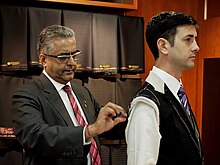This is an old revision of this page, as edited by 68.97.131.85 (talk) at 18:33, 11 April 2022 (Undid revision 1082170458 by LightandDark2000 (talk) I wasn’t doing vandalism, the article had serious problems.). The present address (URL) is a permanent link to this revision, which may differ significantly from the current revision.
Revision as of 18:33, 11 April 2022 by 68.97.131.85 (talk) (Undid revision 1082170458 by LightandDark2000 (talk) I wasn’t doing vandalism, the article had serious problems.)(diff) ← Previous revision | Latest revision (diff) | Newer revision → (diff) A person who makes, repairs, or alters clothing professionally For other uses, see Tailor (disambiguation). "Tailoring" redirects here. For the clothing made by a tailor's measurements, see Bespoke tailoring.| This article needs additional citations for verification. Please help improve this article by adding citations to reliable sources. Unsourced material may be challenged and removed. Find sources: "Tailor" – news · newspapers · books · scholar · JSTOR (February 2014) (Learn how and when to remove this message) |


A tailor is a person who makes or alters clothing, particularly in men's clothing.
Although the term dates to the thirteenth century, tailor took on its modern sense in the late eighteenth century, and now properly refers to makers of men's and women's suits, coats, trousers, and similar garments, commonly of wool, linen, or silk.
Fictional tailors include the tailor in The Tailor of Gloucester, The Emperor's New Clothes and The Valiant Little Tailor. A more recent example is John le Carré's The Tailor of Panama.
Regional styles and cuts

Just as there are various methods of tailoring, there are also styles that differ regionally. This is due to different climates and cultures in the world, causing "house style" cuts of the trade.
British cut
The British cut of tailoring can be defined by various ways of inner construction. Since the United Kingdom has a cooler climate than (for example) the Mediterranean, the cut of the British is more heavy, with a more military influence. This style of canvassing has 3 layers, a wool or camel-hair canvas for the body, a horsehair chest piece for the breast area, and a flannel domette for a more masculine pronounced bulk. The shoulders of the British are more padded. The fabrics used by the British are in the range of 9-13 oz due to the colder climate. This style of cut can be credited to Henry Poole & Co, and H. Huntsman & Sons. The British are also credited in creating their ever-so-popular trademark, the Drape Cut.
Italian cut
Like the British cut, the Italian cut is defined by its inner construction. Since Italy lies in southern Europe and has a warm climate, the Italian tailors developed a cut that was light and cooler to coincide with the conditions. What they developed is called the Italian/European cut. This cut is more light, with fabrics ranging from 7-9 oz. This way of doing canvas has a range of 1-2 layers, a linen body canvas, and a light horsehair canvas. The Italian shoulder is more natural, and sometimes has a “shirt sleeve” with a roping head. The cut is also slimmer than the British, with a more casual setting. The tailors credited with these cuts are Brioni and Rubinacci.
American cut
The American cut of tailoring is a mix of the Italian and the British ways. The American cut is more baggy and full, with a natural shoulder that is lightly padded. American tailoring usually involves doing light canvas, where only the canvas and the flannel domette are used. The most well-known cut developed by the Americans is the Ivy League cut. The tailors credited with this cut remain anonymous.
See also
References
- "Definition of tailor". Merriam-Webster.
- Bridgland, A.S. (2013) . The Modern Tailor Outfitter and Clothier Vol 1. UK: Read Books Ltd. p. 3.
The Oxford English Dictionary states that the word 'tailor' first came into usage around the 1290s, and undoubtedly by this point, tailoring guilds, as well as those of cloth merchants and weavers were well established across Europe.
- "British vs Italian vs American - Suit Fashions & Silhouettes". Gentleman's Gazette. 2019.
| Sewing | |||||
|---|---|---|---|---|---|
| Techniques | |||||
| Stitches (list) | |||||
| Seams | |||||
| Closures | |||||
| Materials | |||||
| Tools | |||||
| |||||
| Manufacturers |
| ||||
| |||||
| Surnames associated with the occupations of tailor/seamster | ||
|---|---|---|
| Germanic |  | |
| Romance | ||
| Slavic |
| |
| Semitic |
| |
| Other | Darzi, Szabó, Raftis/Ράφτης, Terzioğlu, Terzi | |